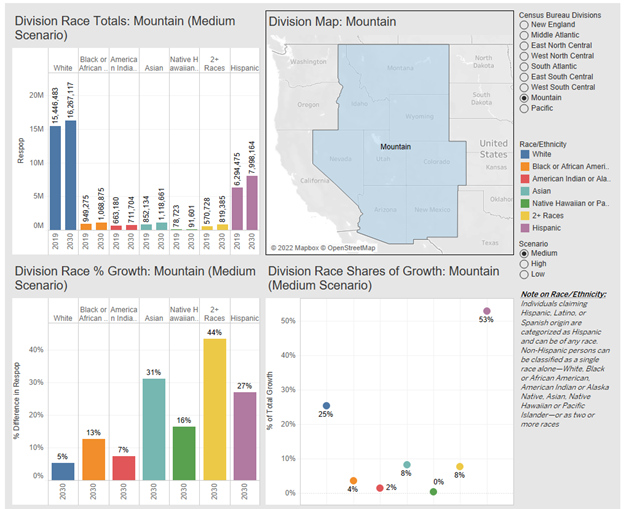Blog Post
Insight: New Product: Experimental Age, Sex, Race and Ethnicity Projections for Every State for 2030, with Scenarios
By: Mike Hollingshaus and Emily Harris
Jun 22, 2022 – The Kem C. Gardner Policy Institute is happy to release a new experimental product: population projections for every state in 2030. These are available by age, sex, race, and ethnicity. High, middle, and low scenarios are also available. We provide datasets, a user guide, and some useful dynamic visuals for exploration (an example for the Mountain states is pictured below). These projections combine other publicly available datasets using transparent statistical methods, as detailed in the User Guide.
Our research usually focuses on Utah, but this special project was funded by the Sorenson Impact Center, also at the University of Utah, who needed more geographically expansive projections for their national higher education planning models.
All population projections are subject to error, and we discuss several potential limitations in our User Guide. It is impossible to predict the future with certainty, especially for race and ethnic projections when individual identities are so wonderfully complex that the full range of human experience simply cannot be expressed by statistics. However, these projections provide a quantitative way to consider important demographic characteristics in crucial national planning efforts. For example, previous research by the Utah System of Higher Education has used our Utah-specific race and ethnicity projections to plan for Utah’s higher education and labor force. This type of research can help shed light on our demographic future.
Data users should utilize these projections to make state-level comparisons on the metrics provided. If seeking projections for an individual state, please seek out independent projections produced by that state. You can find our Utah-only projections by race and ethnicity here.
Mike Hollingshaus and Emily Harris are Senior Demographers at the Kem C. Gardner Policy Institute.
Note: The opinions expressed are those of the author alone and do not reflect an institutional position of the Gardner Institute. We hope the opinions shared contribute to the marketplace of ideas and help people as they formulate their own INFORMED DECISIONS™.







